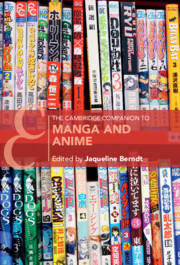Book contents
- The Cambridge Companion to Manga and Anime
- The Cambridge Companion to Manga and Anime
- Copyright page
- Contents
- Figures
- Contributors
- Acknowledgments
- Notes on Japanese Names, Terms, and Titles
- Chronology
- Introduction
- Part I Claimed Origins and Overlooked Traditions
- Part II Drawing and Movement
- Part III Sound
- Part IV Narrative
- Part V Characters
- Part VI Genres
- Part VII Forms of Production
- Part VIII Forms of Distribution
- Part IX Forms of Use
- Further Reading
- Index
- Cambridge Companions to Literature
- References
Further Reading
Published online by Cambridge University Press: 07 November 2024
- The Cambridge Companion to Manga and Anime
- The Cambridge Companion to Manga and Anime
- Copyright page
- Contents
- Figures
- Contributors
- Acknowledgments
- Notes on Japanese Names, Terms, and Titles
- Chronology
- Introduction
- Part I Claimed Origins and Overlooked Traditions
- Part II Drawing and Movement
- Part III Sound
- Part IV Narrative
- Part V Characters
- Part VI Genres
- Part VII Forms of Production
- Part VIII Forms of Distribution
- Part IX Forms of Use
- Further Reading
- Index
- Cambridge Companions to Literature
- References
- Type
- Chapter
- Information
- The Cambridge Companion to Manga and Anime , pp. 267 - 274Publisher: Cambridge University PressPrint publication year: 2024

